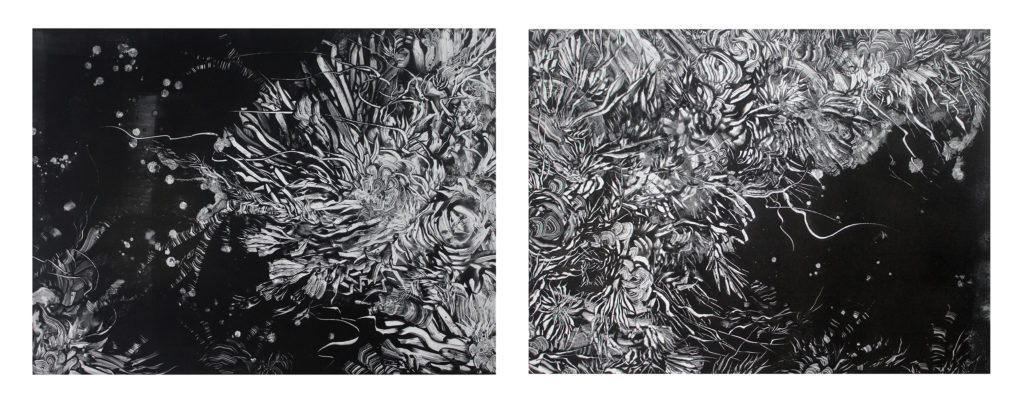
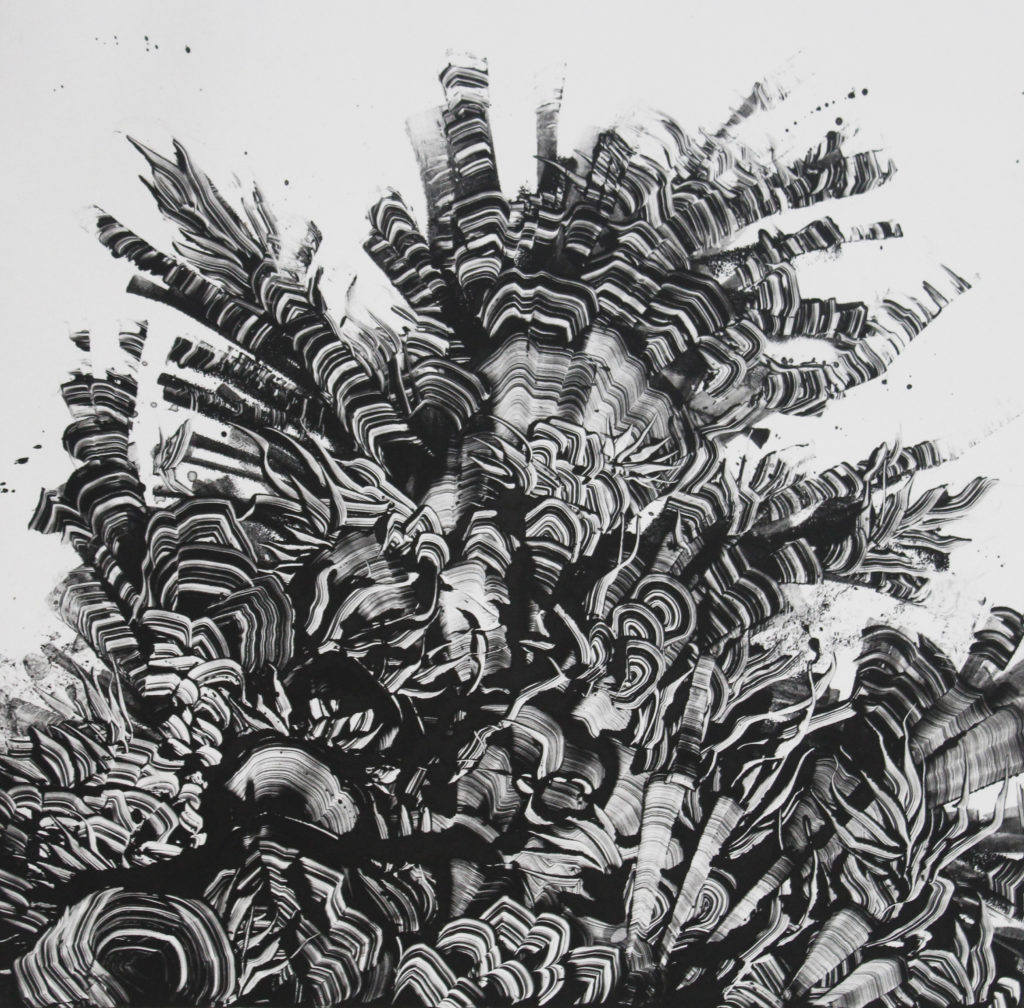

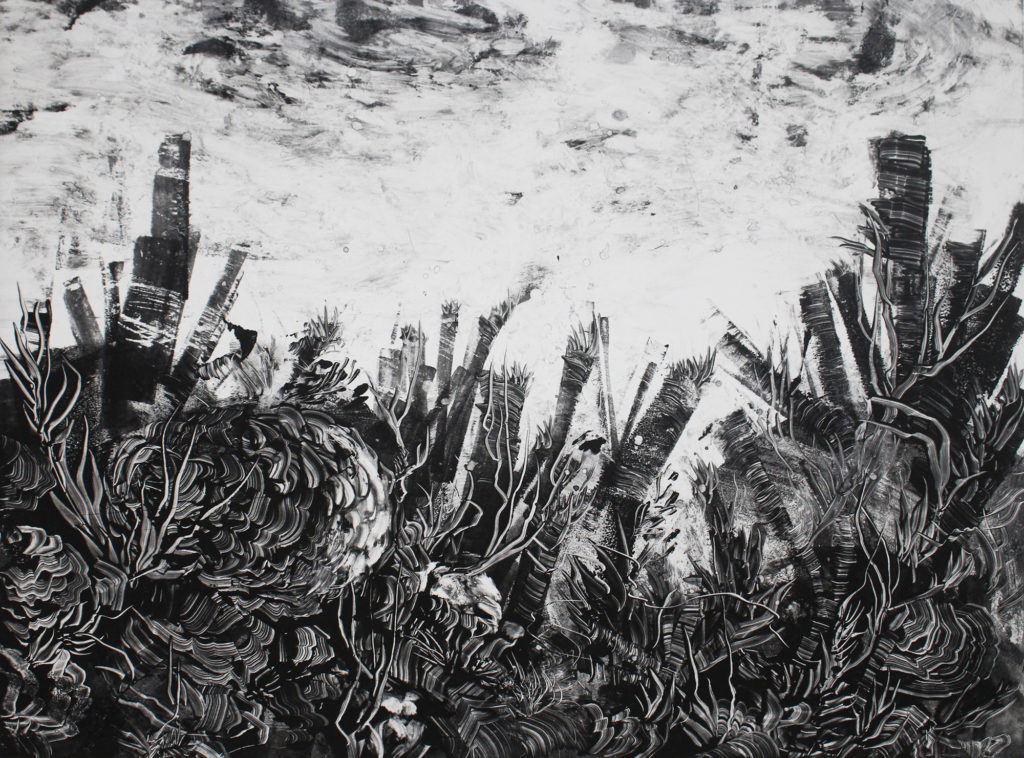
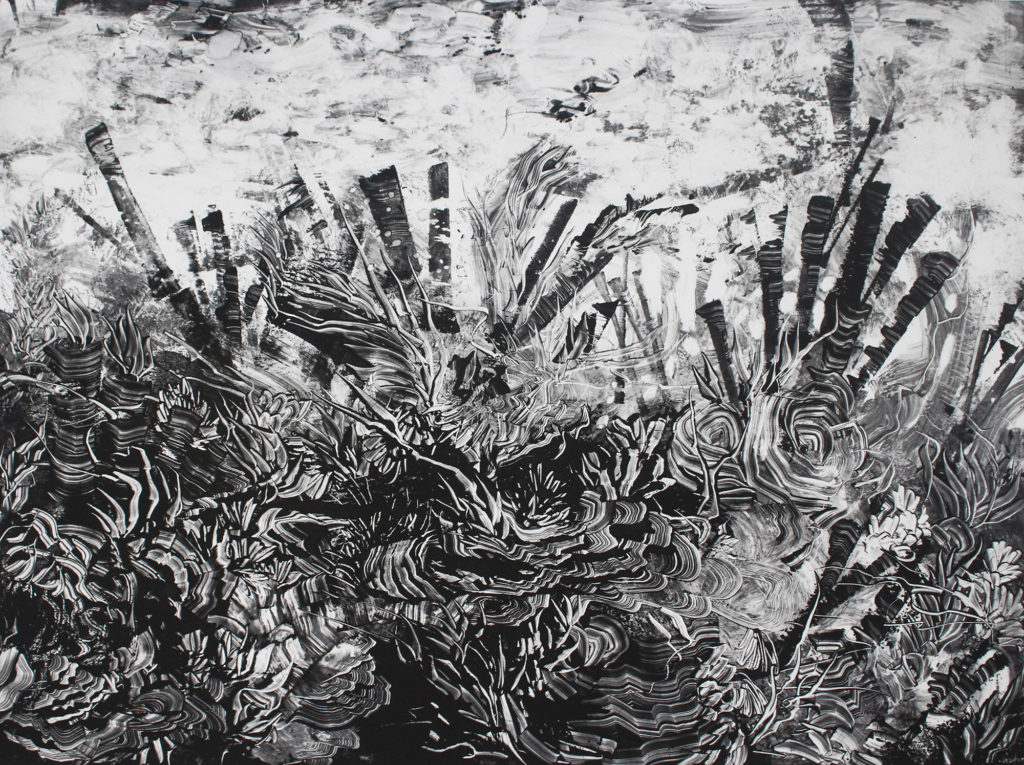
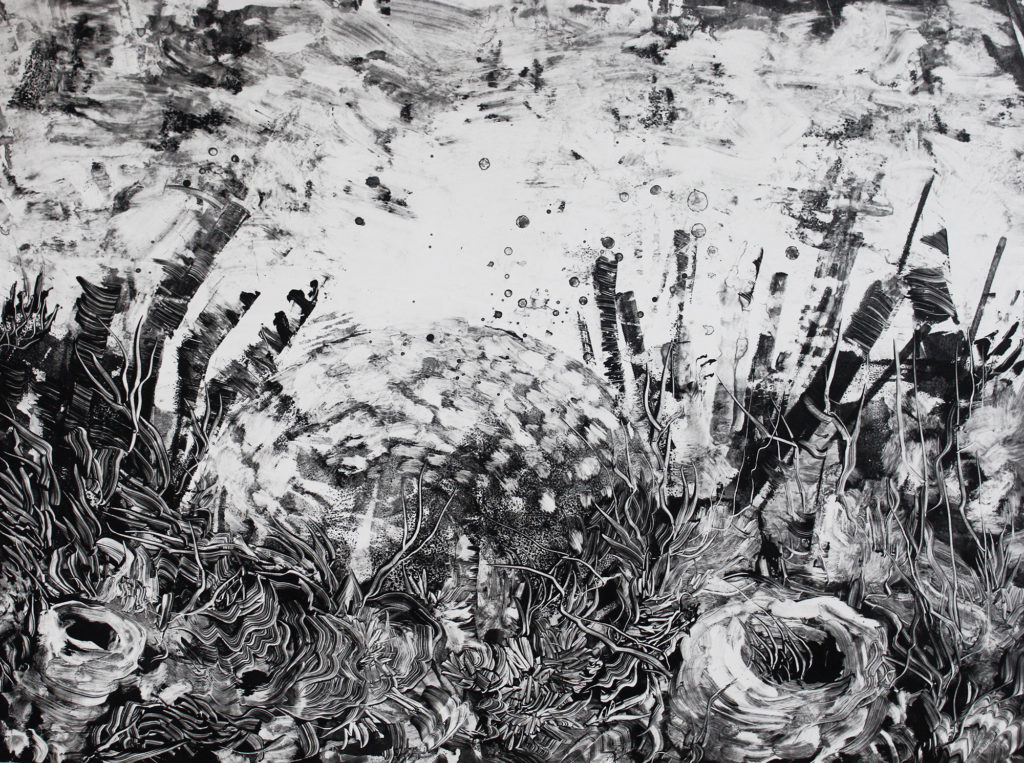
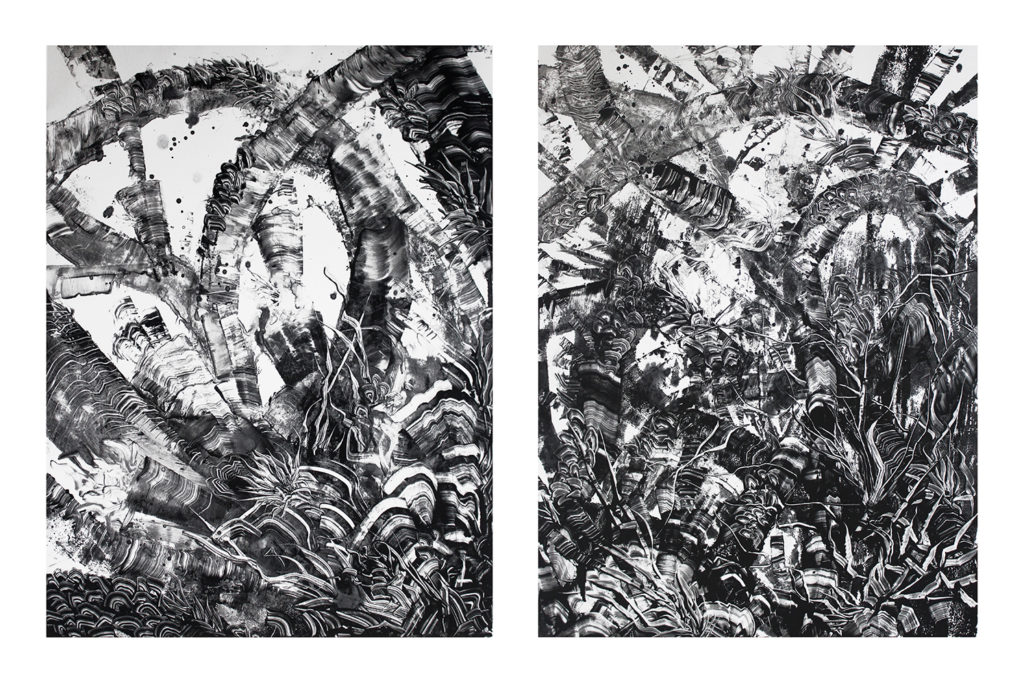

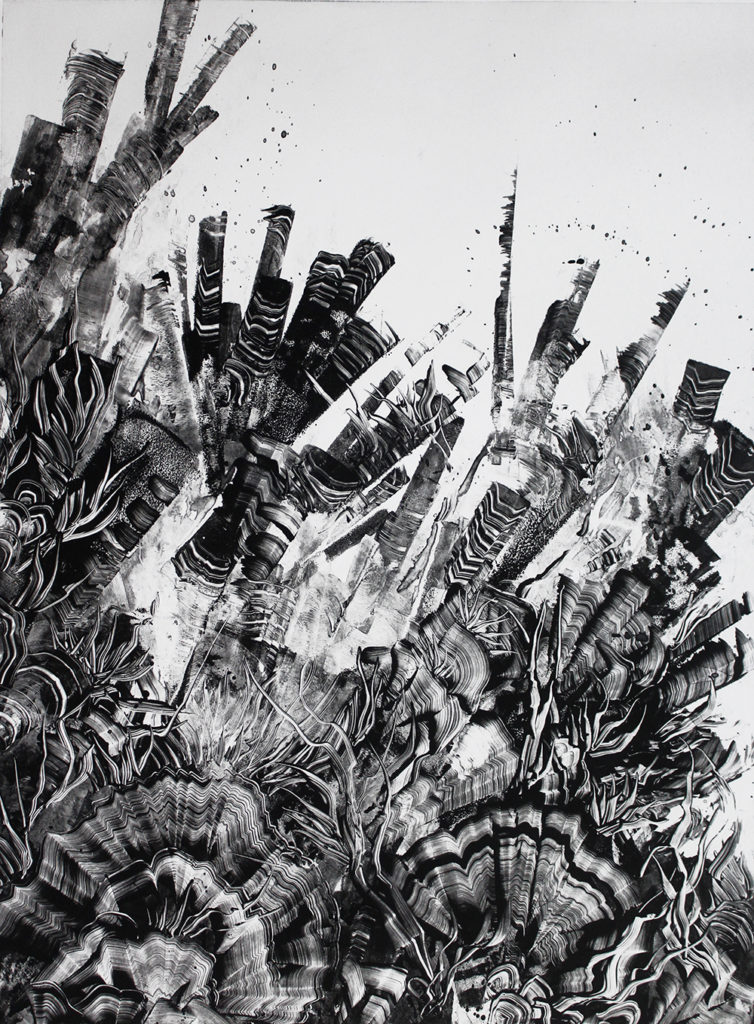
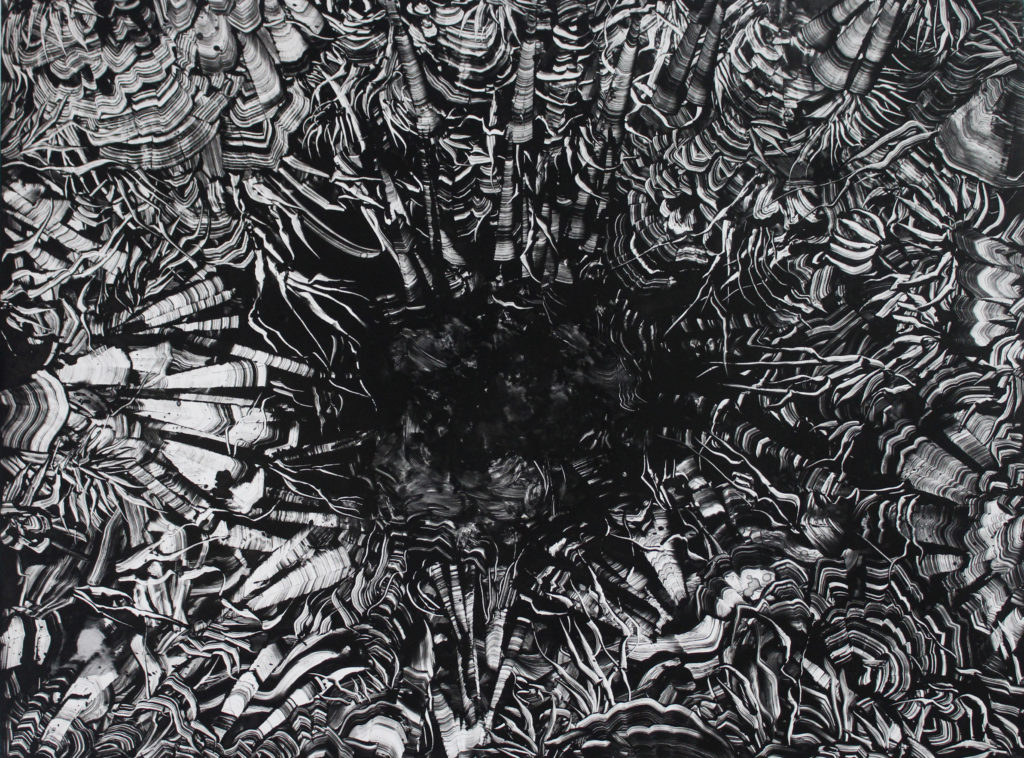
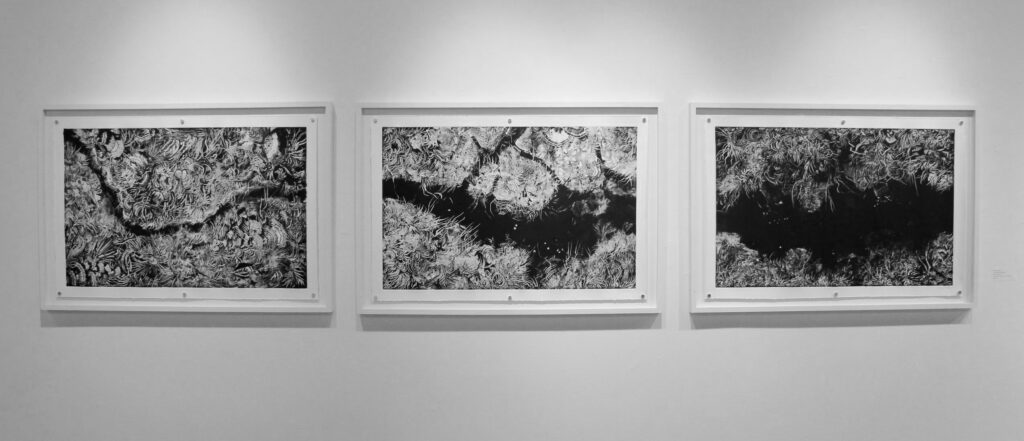
Michael Gray‘s Life Forms is a solo show comprised of new works that address the loss of living reef tissues in Biscayne Bay. This series of monotype prints are a documentation of the current state of the reef system which is being threatened by bleaching, disease, destruction, and pollutants exiting through urban waterways. Though the work depicts a threatened and disappearing ecosystem, the prints are better understood as documentation of the physical experience Gray had encountered in the environment. Gray uses colorless abstracted form, gesture, repetition, and intuitive mark-making to represent his anxieties of habitat loss, the degradation of the natural beauty of his home, the disappearance of coral, and the uncertain future of our oceans. Gray has worked throughout South Florida documenting areas of refuge within the Everglades National Park. Each location, as Gray sees it, can be a microcosmic representation of life all over the globe. Life, death, and regrowth are important to all natural cycles, however, these unsaturated prints offer a view of a colorless, dark, and capricious world on the verge of existence.
Exhibition Texts
Intertidal Network
Mangroves play an essential role in littoral systems by creating networks of refuge for young fish, crustaceans, invertebrates, birds, and other coastal inhabitants. Mangroves also help serve as a natural barrier against the force of the ocean. Their roots, help weave a dense barrier that traps loose sediments and keeps sand erosion down. This image focuses on the subtidal section of these specially adapted plants and reveals the ecosystem in which they create below the water’s surface. This tidal environment is known to be one of the harshest areas for life to survive due to the dramatic changes that happen within it. As sea levels rise, mangroves will move inwards into disparate ecological systems and crowd out existing populations due to the rising salt content or salinization of the soil and groundwater sources.
Sessile Crown
This image was created as a reminder of the future of Miami’s shifting shoreline. Over two thousand years ago, Florida’s west coast extended over one hundred miles out into the Gulf of Mexico. The coral structure serves as a symbolic representation of the ocean’s majestic raw power. The sea has the ability to slowly conquer and annex as it pleases as the immobile ruling force of this planet. Coral tissues are threatened by numerous factors including urban and agricultural pollutants, water acidity, bleaching, temperature changes, sedimentation, overfishing, and careless tourism. This aspect of the image serves as a reminder to try and preserve what is left of our reef and littoral systems before the natural wonder of Florida’s waters is lost.
The Divide
The triptych depicts a deep crack in the earth below the water’s surface. This image illustrates how small fissures can become irreparable abyssal chasms and symbolizes how the unknown can evoke fear. The chasm in this work represents a separation between human action and hidden ecological consequence. The split can also be seen as a representation of socio-political rifts developing between people. These divisions are due to the schismatic and divisive language and lack of constructive leadership currently taking place in office. Legislation is too often written to undermine and inhibit the growth and strengthening of environmental protection policies assisting in widening the divide.
Dark Passage
Coral polyps create calcareous skeletons on which they are attached once they multiply into colonies. Rising water temperatures and increased carbon dioxide intake assist in expelling the algae that coral rely on to survive and leave behind the bone-white forms known as bleached corals. Although bleaching is not fully understood, there are a considerable number of actions humans can take to slow the destructive trend. These actions chiefly include reducing your carbon footprint and collectively acting upon measures to slow the progression of global warming. Such measures include the use of sustainable energy and further reducing the world’s dependence on fossil fuels. Since the 1980s bleaching has begun to take over massive sections of the Great Barrier Reef and portions of reefs in the Caribbean. The dark path in which we are traveling down leads to an uncertain future for not only the ocean’s reef systems but to the twenty-five percent of all sea-life that depends upon it to survive.
Between Breaths
This triptych of coral reef was developed from memories of exploring Biscayne Bay. The swirling water just above the formations place me in the water with them. While looking at this series of works, I become a part of this ecosystem and I am also reminded that my time with it is short. The complex organic structures sway back and forth forever in an endless cycle that, for only a brief time, I can experience. While I lay motionless in the waves, like a piece of driftwood, the current slowly drags me through this alien world allowing me to gaze into the depths in awe and with apprehension. This place, strange and capricious, captivates me and also reminds me that I am not fully adapted to exist in it. My lungs begin to burn, and I come up again for air.
Twilight Formation
Within the ocean, there are just as many, if not more, deep-sea coral organisms that do not need sunlight to survive. There are vast stretches of deepwater coral forests also known as “Cold-Water Corals” that are still being discovered and explored. The formation represented in this diptych stretches out of view while contained by dense black darkness. Shifting into an unknown and monstrous form, the chaos of the tangled shapes and organic structures reach out into the dark feeding, swaying, and growing. This work inherits traits from abstract expressionist artists like Franz Klein and Jackson Pollock while still adhering loosely to recognizable form. Like the work of Matisse, this work takes cues from natural organisms which are reduced and abstracted into biomorphic forms and amorphous shapes. This association of abstract art has connected me to something deeply primal and familiar. Even though I have never seen these organisms before, they have become a representation of my deepest feelings and anxieties connected to the organisms on this planet and their immediate future.
Euphotic Formation
The organisms and coral tissues that exist in Biscayne Bay all live within the euphotic zone. This zone of the ocean is characterized by its water clarity and the amount of light entering it which is sufficient enough to support photosynthesis. Although coral polyps themselves do not actually perform photosynthesis, the symbiotic zooxanthellae algae that live on the corals do. This relationship begins with the polyp’s dietary output of CO2 when it feeds on plankton. The algae then take that carbon dioxide output and use it to generate oxygen and the organic products of photosynthesis which, in turn, nourishes the coral. These algae are also responsible for the vibrant colors coral reefs are known to possess. This relationship can be off-balanced by many factors but the most pressing is global warming. The zooxanthellae can only exist within a small margin of water temperature fluctuation and once the water becomes too warm, the coral expel their algal partners and begin to die of starvation. Coral reefs are the first in line to suffer from climate change. Twenty-five percent of the world’s marine life depends on coral reefs and losing these habitats will severely jeopardize their chances of survival.
Eutrophic Settlement
Eutrophication is the process in which a body of water becomes nutrient-rich (usually in nitrates and phosphates) due to the runoff of agricultural and civilian fertilizers. This nutrient-rich water allows algae populations (other than zooxanthellae) to thrive and create what is known as an algae bloom. This is when the water becomes thick enough with algae that all light is blocked from the lower depths and the water is starved of oxygen creating slicks of toxins, massive fish kills and severely reduces an organism’s ability to perform photosynthesis. The contaminated water is often released first into estuaries and further into the ocean where the toxins and chemicals do a number on coral reefs. The National Oceanic and Atmospheric Administration recognize that sixty-five percent of US estuaries and coastal water bodies are “moderately to severely degraded by excessive nutrient inputs”. When nutrient-rich water is introduced into a coral reef, studies show that the Zooxanthellae use the nutrients to multiply while coral growth stops. This imbalance of polyp production can lead to an invasion of bacteria and other diseases which will, in turn, weaken and possibly destroy the coral colonies being affected.